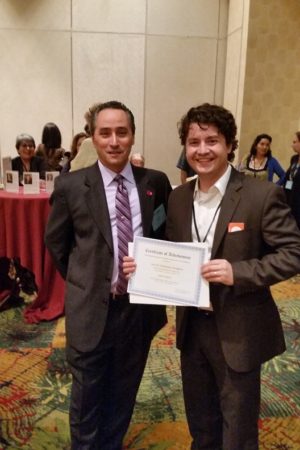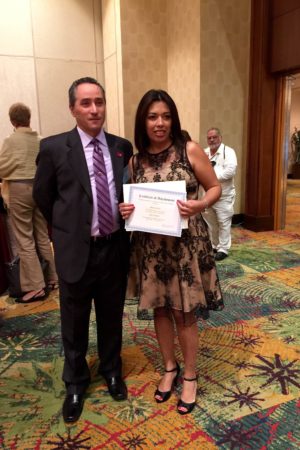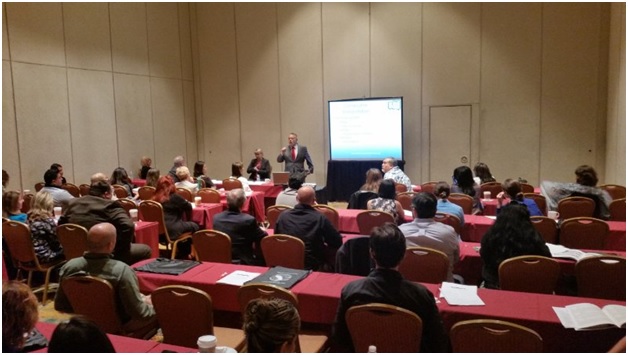
Proteus
Issue: 2016 Summer Volume XXVIV Issue No 2Table of Contents
Editor's Corner
Letter from the Editor: Summer 2016

I laughed out loud when I read this issue’s question in Ask an Interpreter: “Why do interpreters wear such unfashionable shoes?” As a court interpreter who spends her day strolling between the criminal and family courthouses and walking up and down stairs when our elevators fail, I have voted for practical over fashionable. I watch as other court employees hobble by, sporting stilt-like heels in the latest styles, while I walk briskly past in my plain Mary Janes. Thank you to Dan DeCoursey for validating my choice in footwear! My “winged sandals” may not be attractive, but they let me fly into the courtroom twice as fast, and blister-free to boot!
It behooves court interpreter communities to formulate and implement a judicious approach, practice, and policy on the subject of text messaging. Instructing courts and attorneys as to the difficulties of “making sense” of text messages, and reaching consensus as to what constitutes reasonable expectations and adequate working conditions when we are assigned the challenging task will help us do our job to the best of our ability, knowledge and expertise.
Speaking of flying, we had a wonderful turnout of attendees traveling to our yearly conference in San Antonio this past May. Even if you weren’t able to make it, never fear! In this issue of Proteus, read Rosemary Dann’s Conference Roundup and the reflections from our scholars and award recipients, as well as thoughts on NAJIT’s future from guest contributors Janis Palma and Agustin de la Mora. Also, James Nolan also offers a timely commentary on Brexit.
We have two wonderfully insightful and informative articles as our feature pieces this issue. In her article “Maximizing Existing Processing Capacity in Legal Interpreting,” Denise Green introduces a concept she calls “scan and drop.” In order to maximize output ability, we need to train our brains to concentrate only on the necessary input, putting all else aside, and she provides us with practical instruction on doing just that. Then in Pilar Meyer’s article, “Decoding and Constructing Meaning from Text Messages: Pragmatic Considerations for Court Interpreters,” we deconstruct that all-important piece of evidence that can be the bane of interpreters’ existence: the text message. Put the two articles together and we can learn how to decode text messages and then scan and drop our frustration while we interpret at maximum processing potential!
Of course, we have our old standbys in this issue too: “Backlash” is the new word of the month in Cracking the Code, and Douglass Hal Sillers gives us a poetic description of interpreting modes in For Better or Verse. In Interpreters Everywhere, Maria Teresa Perez provides a poignant description of an interpreter’s journey, both professional and geographical, as she recounts her experience as an interpreter on both sides of the continental United States. To finish the issue off as always we have Links of Interest and Notable Quotables.
And with that, dear readers, I must finish off myself by bidding you my final adieu. I was recently accepted as a Master’s degree candidate at the Middlebury Institute of International Studies. I have regretfully handed in my resignation with the New Jersey Judiciary. I intend to work on my French in Montreal for the better part of the coming year. It is therefore with mixed emotions that I inform you that this issue marks my last one as Editor-in-Chief of Proteus. It has been an honor to serve in this position and I could not have done it without my faithful team. I wish you the best as my “winged” Mary Janes take me on my next chapter.
Warmly,
Athena Matilsky, Proteus Editor-in-chief
Meet the Editors: Summer 2016

Arianna M. Aguilar has a degree in communications and has been interpreting and translating since 1999. She has been a certified court interpreter in North Carolina since 2005, and master certified Spanish-language court interpreter since 2013. She is president of Latino Outreach Consulting of NC, Inc., a translation and consulting agency, and is a published author. She has given presentations on a range of topics at both NAJIT and American Translators Association (ATA) conferences.

Rosemary Dann currently lives in Phoenix, AZ. (Yes, but it’s a DRY heat.) She holds a B.A. and M.A. in Spanish language and literature, as well as a J.D. degree. She is also a Massachusetts state-certified Spanish-language court interpreter. She has worked as a high school and college instructor, held various law jobs including law clerk to two judges, a public defender, and a private practitioner, and has free-lanced as a judiciary interpreter in Massachusetts, New Hampshire and Florida. She joined NAJIT after attending “The Institute” in 1999 (thank you, Cristina Helmerichs!) and has since served on numerous NAJIT committees and on the Board of Directors for six years, two as chair. She took over the position of editor-in-chief of Proteus upon Nancy Festinger’s retirement from that post, and now turns over the reins to the very capable Athena Matilsky. She is staying on staff as the unofficial “advisor-in-chief”, as she has returned to college as a theater major in performing arts. Her bucket list includes visiting Machu Picchu, seeing her son married, and appearing in a national TV commercial.

Dan DeCoursey is a state and federally certified court interpreter in San Diego, as well as an ATA-certified Spanish>English translator. After working for several years as a teacher and textbook editor, he was ready to make a change, so he moved to Guadalajara, Mexico, where he earned a master’s degree in translation and interpreting from the Universidad Autónoma de Guadalajara. He has over a decade of experience working as an interpreter in both state and federal court, and as a freelance translator specializing in legal documents. Currently, he is a staff interpreter at the U.S. District Court for the Southern District of California (San Diego).

Cecilia Golumbeanu is a Romanian-language court interpreter and a French-language translator in New York. As a Fulbright Scholar at the University of Michigan in Ann Arbor, she wrote a legal and economic bilingual dictionary of American and European terms, published in 2005 in Romania. She has a bilingual blog of thoughts and links on language, arts and science.

Feature Articles
Decoding and Constructing Meaning from Text Messages: Pragmatic Considerations for Court Interpreters

By Pilar Cal-Meyer
Text messaging has become one of the most ubiquitous and convenient means of communication in our times. People from virtually every sociocultural and linguistic background in the United States have at their fingertips a new way to exchange information and to express themselves. Text messages, however, can also be sensitive materials in a court of law, especially when written in languages other than English, or LOTE, because they have to be construed or decoded1, and inferred by the outsider2 interpreter. The use of text messaging has undoubtedly opened up a whole new chapter in the legal arena, and a new dimension in court interpretation, translation, and forensic linguistics.
Form
While text messages can be dictated voice-to-text, it is usually the fingers “speaking” the minds of the communicators. Indeed, text messaging has been referred to as “fingered speech.” (Copeland, 2013). Though delivered in written and visual structures, the language of text messages resembles spoken utterances3 with all of the components and complexities of oral communication. It is precisely the hybrid nature of text messaging4 that makes it a fascinating subject from a linguistic standpoint. Speech-like forms are seemingly “wrapped” or encoded in written-like forms to give rise to a speech-writing-plus hybrid language in its own right, not just as the result of the implementation of two modes of language. The new hybrid language constitutes an artefact with uncertain linguistic, pragmatic and cognitive ends that deserves professional attention.
From a user’s perspective, it is the simplicity of the speech-like features that attracts people from all walks of life to engage in text messaging. Everyone welcomes a forgiving means of communication that allows interlocutors to speak their minds freely and naturally in casual registers without being judged for flouting grammatical correctness or rules of conventional writing. It is a relief, some will say, to be able to blame imperfect technologies, e.g., electronic glitches and stubborn spellcheckers for one’s own personal oversights.

The present discussion focuses on the processes of constructing/deriving meaning from text messages and not as much on decoding. After all, decoding or cracking literal and semantic meaning is a well-understood process and a more predictable task than figuring out intended meanings ostensibly inferable in text messages. Interestingly enough, electronic glitches or typos, poor grammar and other irregularities produced by parties are not the main concern in constructing meaning. This paper does not focus on the translation process either, since finding linguistic and cultural equivalents in the English language is no different from what we do in our everyday job when doing face-to-face interpreting. The chief challenge, as I see it, consists in figuring out how to construct meaning or “make sense,” if at all possible, from explicit linguistic forms and from pragmatic signs produced in private communications.
Please note that the terms “decoding” or “construing” pertain to recovering meaning from linguistic forms, and “constructing” relates to inferring meaning from pragmatic evidence, that is, from ostensible cues and logical assumptions.
The speech-writing-plus hybrid language
As stated above, the language of text messages is more than a simple amalgamation of spoken and written form, i.e. more than the sum of its parts. The idiosyncratic speech-writing-plus hybrid language is neither produced by the vocal cords nor heard by the human ear, but it shares important features with face-to-face conversation as well as with the written mode of language.
Parallels between text messages and face-to-face interaction
- Interactivity occurs in both modalities.
- Speakers and text messengers engage in turn-taking when they converse, taking the floor for relatively brief turns.
- Dialogues are un-planned and spontaneous.
- Speech is direct and immediate.
- Conversation is synchronic.
- Speakers and text messengers digress and shift topics abruptly.
- Speakers receive immediate feedback (in texting some sporadic delays may occur).
- There is abundant use of colloquialisms, vernacular terms, slang, intimate expressions, interjections, onomatopoeia and other speech features and patterns.
- Mutual understanding of coded and contextualized communication is common.
Parallels between text messages and the written mode of language
- Usage of an orthographic and typographic system is necessary to encode (produce) and decode (read/decipher) visual representations in the form of graphemes and orthographic signs.
The following elements are also unique to text messaging and most challenging for outsider interpreters:
- Private and ambiguous language impervious to outsiders
- Highly contextualized coded communication between interlocutors
Uniqueness of the speech-writing-plus hybrid language of text messaging
There are startling phenomena exclusive to the speech-writing-plus hybrid language:
- Excessive and continuous presence of grammatical inconsistencies and gaps
- Fragmented and short speakers turns; very short exchanges; intermittent and interrupted conversations that can go for minutes, hours or days
- Overuse of ever-changing and spontaneous shortcuts, abbreviations, onomatopoeias, alliterations, acronyms
- Use of ‘emoticons,’ iconic symbols, visual representations familiar only to parties
- Whimsical ways to economize space on the screen and to minimize effort in processing (e.g., the use of the letter “k” for all similar sounds as in “c” “qu” and “k” in Spanish)
- Electronic glitches, faulty and stubborn spellcheckers consistently obstructing comprehension and altering the meaning of the message
- Encapsulation or minimization of ideas, statements, propositions and other language forms to their minimum expression
- Limited use of discourse markers, e.g., adverbs, conjunctions, prepositions, deictic pointers, and other referents of space, time and persons/pronouns
- Limited use of cohesion markers, markers of transition, etc.
Unclear discourse patterns and peculiar configurations of composition and organization; unclear anaphoric references - Poor adherence to principles of relevance, amount, quality and other descriptive and prescriptive qualities of the written and speech modes
Definition of text messaging
In general, a text message is a short message sent and received through a device such as a cellular phone, PDA or pager. Text messaging is used for messages that are no longer than a few hundred characters. The term is usually applied to messaging that takes place between two or more mobile devices.
An electronic message is sent over a cellular network from one cell phone to another by typing words, often in shortened form, as “l8t” for “late,” on the phone’s numeric or QWERTY keypad.
In a pragmatic sense, text messages are short entities of speech-like forms combined with written-like forms resulting in a speech-writing-plus hybrid language used between two or more individuals via electronic/digital data for personal communication.
At the discourse level5, a text message is an electronic interaction/conversation whereby meaning is cognitively negotiated and co-constructed between the text author (transmitter) and the reader (receiver). Their mutual understanding heavily relies on how they co-construct implicit and explicit meanings as members of a speech community, from personal and social cues and from spaces of commonalities, differences, power relations and identities.
Meaning
Decoding and inferring
“In verbal communication, the starting point is the small hint given by the encoded meanings of linguistic expressions.” (Clark, 2013). Deriving and constructing meaning from text messages is attained by first decoding the linguistic structures, but semantic and literal structures alone can only tell so much of the story. Speakers and text messengers need to “fill in the gaps” to make sense of their interlocutors’ signs and intentions. In turn, interpreters too will have to fill in the same gaps to make sense of what they read in text messages assigned to them in order to figure out what parties say and intend to say.
To an extent, Seleskovitch’s metaphor (Seleskovitch, 1978, as quoted in Wilcox, 2005) of court interpreters as “mind-readers” merits reflection because even when “we cannot and do not assume that we know what is going on inside the heads of the speakers, we do make assumptions about what people are meaning […].” (Wilcox, 2005).
[Some models] of communication…assume that language encodes meanings, and that understanding is the mechanical process of decoding. Other models of communication … recognize instead that comprehending language is a process of constructing meaning, arriving at conclusions of what someone’s meaning and intentions might be on the basis of the perceptible evidence that they produce – the sounds or the signs that they make when they use language. (Wilcox, 2005).
With that said, the terms decoding and inferring are dissimilar. According to Wilcox and Shaffer,
…cognitive linguistics does not assume a code model in which communication is achieved by encoding and decoding messages. Rather, cognitive linguistics works from an inferential model in which communication is achieved by producing and interpreting6 evidence. (Wilcox, 2005).
And as Sperber and Wilson (1995:12–13) note:
…inferential and decoding processes are quite different. An inferential process starts from a set of premises and results in a set of conclusions which follow logically from, or are at least warranted by, the premises. A decoding process starts from a signal and results in the recovery of a message which is associated to the signal by an underlying code. (Wilcox, 2005)
By “forming a hypothesis about what someone intended to say by an ostensibly communicative act” (Clark, 2013), interlocutors follow lines of inferential reasoning and assumptions in order to decode and construct meaning. Court interpreters constantly engage in inferential work, though it should be clear that inferential work is not the result of guessing or speculating but the result of logical deductive reasoning.
Court interpreters as language experts
Decoding and constructing meaning from text messages is not equivalent to face-to-face interpretation or to translation. However, like an alchemist, the interpreter-translator is expected to turn abstruse and disjointed segments of private conversations into intelligible and accurate renditions, often on the spot. The reality is that the job requires specialized knowledge and skills, an analytical mind and a judicious approach. Making sense or constructing meaning from statements in text messages is indeed the province of forensic linguistics7, given the linguistic, pragmatic and legal knowledge required to work with such evidentiary materials. Fortunately, most trained and experienced court interpreters are equipped to do the job very well.
Needless to say, working with text messages is a more sensitive and complex task than face-to-face interpretation. More needs to be assumed and inferred in text messages because intended meanings and words have already been materialized in the past; meaning is now “frozen” in time and married to its contextual variables and relational parameters, mostly unknown and often unfathomable to the interpreter.
Human communication is not a linear event but a complex activity involving multiple levels of linguistic, pragmatic and cognitive affairs.

Some distinctions between working with face-to-face human beings and text messages:
Face-to-face interpreters see facial expressions, physiognomic features, demeanor, way of dressing, acting and other visual features captured in real time that facilitate a minute-by-minute synchronic assessment of the speaker’s reactions and demeanor; there is no visual input whatsoever in decoding/inferring text messages.
Face-to-face interpreters rely on phonological and prosodic cues from which pragmatic meaning is drawn, e.g., tone of voice, pitch, loudness, inflections, intonation and other systematic vocalizations; there is no prosodic input whatsoever in decoding/inferring text messages.
Face-to-face interpreters are always allowed, even required to check with the witnesses for clarifications to receive feedback on any issue arising at the moment; there is no possibility of asking questions about a decontextualized and opaque text message.
Translations of text messages will usually stand as true and valid, even if poorly executed (!) unless one of the parties moves to contest a dubious rendition. Therefore language professionals bear a remarkable responsibility. The monumental task demands expertise, thorough analysis and careful execution. Neither court expeditiousness nor obsequious diligence should undermine the spirit, purpose and aims of language access and due process.
It is important to know that messages written by limited English proficient individuals are more susceptible to legal repercussions than those written by Anglophones because messages in English can be parsed, stipulated, and argued by all stakeholders in the case who are speakers of the mainstream language: English. However, messages written in LOTE are required to be translated into English. To that end, the process starts with decoding linguistic expressions and constructing inferable meaning through the interpreter’s subjectivity, judgment and schema8. Next, an additional layer of discretionary linguistic and cultural constraints involved in the translation process will take place. In other words, while constructing meaning and while translating (or performing language interpretation), everything said by the speaker is force-fitted into one person’s version—that of the interpreter. At the end of the day, all parties will follow procedure based on the court interpreter’s renditions.
Legal concerns in text messaging
Words meant as mundane exchanges in a private digital conversation can turn into evidence at a moment’s notice. Once transmitted and received, it will be impossible to retract them. Since digital texts are suitable for private and spontaneous expressions between intimates, it is often the case that excited utterances and any suspicious linguistic forms are subject to be construed as incriminating statements that can be considered discovery materials and thus evidence in a court of law.
Just as in face-to-face interpretation, translations can also be deemed prima facie evidence whereby the words of the translator are regarded as the words of the speaker. This approach champions the view of the interpreter as a conduit. The language conduit theory is premised on a deeply flawed understanding of language interpretation and it may be obliterated nationwide in the near future9. In contrast to certain courts and circuits of appeals that uphold the legal fiction of the conduit model, others are adopting new approaches from recent case law that reject the conduit model. These jurisdictions acknowledge instead that language interpretation and translation are subjective and discretionary and can consequently be regarded as hearsay if challenges are raised by defense counsel because the interpreter’s renditions can be viewed as the interpreter’s own statements, and not as those of the limited English proficient person. Currently, the Eleventh Circuit has expressly rejected the language conduit theory as inconsistent, and its jurisdictions require that interpreters/translators be made available for cross-examination if out-of-court interpretations or translations of text messages are presented as testimony according to the confrontational clause of the 6th amendment.
Translations of text messages will usually stand as true and valid, even if poorly executed (!) unless one of the parties moves to contest a dubious rendition. Therefore language professionals bear a remarkable responsibility. The monumental task demands expertise, thorough analysis and careful execution. Neither court expeditiousness nor obsequious diligence should undermine the spirit, purpose and aims of language access and due process.
Pragmatic considerations
Now that some points have been made as to the nature of the speech-writing-plus hybrid language and on constructing meaning, it will be helpful to get acquainted with a few pragmatic concepts, even if in an oversimplified way.
Pragmatics is the study of language in context, or what we do with language. Basic concepts of pragmatics can assist interpreters to become aware of crucial facts when constructing meaning from text messages.
From Pragmatics by Jean Stilwell Peccei (Peccei, 2007):
“Pragmatics is the study of how more gets communicated than is said.” (Yule, 1996, p. 3).
“There is a distinction between a hearer’s knowledge of her language and her knowledge of the world. […] I shall argue that it is this distinction that underlies the distinction between semantics and pragmatics]”. (Blakemore, 1992, p. 39)
While we cannot venture to guess the intended meaning of a text messenger, we cannot rely exclusively on the literal and semantic meaning of the words either. There are signs and forms, and there are pragmatic cues and cognitive tools from which to infer and construct meaning in consistent ways. The description by Chapman below can be very elucidating:
Pragmatics is often described as being a branch or field of linguistics; indeed, categorizing it in this way makes a lot of sense. Linguistics is the academic subject that is concerned with the analysis, description and explanation of human language and pragmatics contributes to this project by focusing on the interaction between language and context. But perhaps strictly speaking, pragmatics should be described outside of and separate from mainstream or ‘core’ linguistics, [that is, from linguistics’] ‘core’ components including phonology, morphology, syntax and semantics. Pragmatics stands apart from these because its subject matter is not, or not exclusively, language itself but the production and interpretation10 of language in relation to contexts of use. In that way, pragmatics is distinguished from ‘core’ linguistics by being concerned not just with the linguistic component of the mind but with a much larger set of knowledge and cognitive processes concerned with the interpretation of communication in context. (Chapman, 2011) [Emphasis added.]
Pragmatic studies assert that the forms or signs in language fall short of the story behind them; accordingly, there is much more than meets the eye, so to speak. With that line of reasoning, pragmaticists agree in that “…there is always a significant gap between what it is linguistically encoded and what speakers actually intend by their utterances.” (Clark, 2013) In relevance theory, this gap has been termed as the underdeterminancy thesis to reflect the idea that “linguistically encoded meanings always significantly underdetermine intended meanings. The gap between what is [linguistically] encoded and the meaning we eventually arrive at is filled by pragmatic inference.” (Clark, 2013)
Contextualized/decontextualized text messages: speakers’ variables
If it is true that text messages can be used by individuals relatively distant on a social continuum, (boss and employee; doctor and patient; teacher and student, etc.), most interlocutors are intimates, i.e. close individuals, (relatives, friends, spouses, romantic partners). When intimates communicate there is a presumption of a mutually accepted direction of the conversation or a seemingly implicit understanding of the main line of thought. By using previous frames of reference, text messengers anticipate, predict and infer meaning from each other as if following a cooperative force of communication similar to face-to-face conversation. Conversely, for the outsider party, such as a court interpreter, the language and intentions of written in the exchanges is unknown territory.
Accordingly, speakers, including text messengers, adopt their language to accommodate their communication needs, i.e., the style of speech, register, regionalisms, metaphors, slang, idioms, words of affection, expletives, abbreviations, etc. They also recognize their membership according to speech community, ethnicity, culture, socioeconomic status, educational background, and tacit agreements as to the dynamics of the power relations between them. It is not surprising then, to realize that the closer the relationship between the text messengers, the less explicit their exchanges might need to be. However, for the uninvited outsider interpreter, decoding and constructing meaning from such close/closed communications becomes a major challenge.
Therefore, to say close and closed communication11 is to say contextualized12 communication from the perspective of the interlocutors familiar with the context, the subject matter of their conversation and the meanings they co-construct. However, it is decontextualized language13 from the perspective of the outsider court interpreter. Highly contextualized/decontextualized communications can make the court interpreter’s job very difficult and sometimes unworkable.
Speech Acts
Speech act theory is a subfield of pragmatics that can help to describe how speakers use language to produce a result or a response in their hearers. For instance, interlocutors engage in speech acts to express thoughts, intentions, states of mind and a range of moods and emotions. The theory was developed by the philosopher J.L. Austin and later on by John Searle, and its principles are definitely central to pragmatics to making a distinction between “what a sentence literally means and what he can be used to do or to perform.” (Chapman, 2011)
When speaking or writing, or when ‘finger-speaking’, interlocutors perform various “acts”: locutionary14 acts, illocutionary15 acts, and perlocutionary16 acts. “The difference between locutionary and illocutionary acts is sometimes referred to as, respectively, the difference between “saying” and “doing.” (Meyer, 2009) The main interest of speech act theorists’ revolves around speakers’ intentions or the illocutionary force, that is, the intended effects of speech acts, i.e., requests, commands, orders, threats, apologies, promises, etc.
Since words and utterances do not have fixed values or absolute meanings, the statement in Spanish “ya verás…” [you’ll see…] in the example below can have more than one meaning depending on a number of contextual variables. Therefore, what appears as a straightforward and clear statement can mean something very different if taken at face value. It is not unusual to think that a “safe” way to work with an isolated statement is by assigning semantic values to each word. And yes, that is a way to deal with isolated or ambiguous segments of language. Nonetheless, the professional court interpreter has the responsibility and ability to look into the psychological process of the speakers and the linguistic evidence in the text message in order to figure out what they were trying to communicate in any given exchange. Literal meaning alone is not enough to name the speech act below. Is it a threat, a promise, a prediction, or a different speech act?
“Ya verás” [You’ll see] Is this utterance…
A prediction?
A threat?
A promise?
A prediction
Notice how a few contextual clues can help to disambiguate the illocutionary force or intended meaning of the message. If we know that the words “you’ll see ” were texted by an eye doctor to a patient after treating him, the speech act would be a prediction about the patient’s ability to perceive visual stimuli through the eyes, or to see at a later time. Without such additional information, e.g., the roles and relationship of the speakers (doctor-patient), it would be difficult to establish the purpose and intention of the utterance. If additional exchanges are offered, such as “…as soon as I remove the bandages” the pragmatic meaning will be more ostensible.
A threat
The very same words “you’ll see… ” texted by a husband to his wife from the jail after his arrest on domestic violence charges could be construed as a threat, and the speech act as a threat too, especially if they are followed by a second text message like “you bitch…” However, if the utterance “ya verás” [you’ll see] was submitted as such and no clues were available for the interpreter in regard to the circumstances, the speakers, or the allegations, then, there would be no choice but to render the statement/utterance literally. The cautious interpreter would appropriately refrain from deeming the speech act as a threat and from rendering a pragmatic meaning that is not ostensible.
A promise
The same words can come from a man addressing his girlfriend with the intention to convey a promise, e.g., “you’ll see… next time I’ll wash the dishes”.
The example above illustrates that the court interpreter will need more than literal or semantic information before she can decode and construct a reliable meaning.
Basic pragmatic tips toward decoding and constructing meaning
One has to ask: Does the text message make sense in its own right, without any context or additional segments of language, or does it require additional information in order to derive pragmatic meaning? What is the propositional content of the utterance? Is this direct or indirect speech? Is the meaning explicit or implicit? How literal or figurative is the utterance? Is it metaphorical, ironic, sarcastic, intimidating, angry, neutral, vague, etc.?
Could the message prompt disputed meanings among colleague interpreters or more than one interpretation? What inferences can be drawn? What presuppositions can be made? Does the utterance point to a place, time, or people, or to previous references in the same text or in earlier texts in the chain? Are there other possible cognitive interpretations more (or less) prejudicial than others? Who is saying it? How are the interlocutors related? What are the relationships of power between the two? What are the circumstances sustaining the conversation? These are all questions within the domain of pragmatics.
Without information as to some of the speakers’ variables (age, gender, relationship, vernacular, relationship of power, etc.) it will be difficult to provide a fair rendition. How utterances are said, where, when, by whom and to whom provide essential information as well.
Additional pointers and considerations:
Admitting the impossibility of decoding or constructing meaning when the texts are unworkable is a commendable practice—an act of ethical standards and good judgment. On the other hand, “playing it safe” without exploring instances whereby educated inferential operation and deductive/inductive reasoning are appropriate is not.




Helpful Hints
Certain mental tools become critical to meaning construction, decoding and translating text messages. With that in mind, try to:
- Inquire about the speakers’ variables (i.e., age, gender, and socioeconomic status, cultural and ethnic background).
- Ascertain as best as possible the messengers’ shared knowledge. The closer the messenger parties, the more coded the language will be and the harder for outsiders to comprehend.
- Analyze and determine what type of speech act is contained in the text or chain of text messages based on grammatical and pragmatic cues, e.g., is it a command, a request, a confession, a threat, a proposition, an invitation to certain action, etc.?
- Disambiguate the message based on linguistic forms and on pragmatic inferential reasoning.
- Identify discourse indicators of relations and/or asymmetries of power. What is the relationship: are they coworkers, classmates, dating partners, man and wife, etc.? The style of language used between intimates (either equal or unequal), and between dominant and subordinate parties display specific discourse referents.
Obtain as much information as possible from attorneys in order to build context
- Familiarize yourself with the police report and with prosecutor and defense narratives in order to have more context and a “story line.”
- Ask attorneys the nationality of their clients, their vernacular, speakers’ variables and the power relationships between the parties exchanging text messages.
- Make a quick assessment as to how long it will take you to complete the job.
- Check the whole string of exchanges if available, even if you’ve been asked to translate just one particular turn/exchange; make sure the exchanges are in chronological order.
- Check the times, names and turn taking for each messenger to establish a linear sequence.
- Work with other colleagues and have all your tools and resources available.
- Check that the names are ascribed to the corresponding parties.
- Ascertain whether the message is disrupted or delayed more than a few minutes, hours or days?
- Find out whether the message is truncated?
- Disambiguate: literal meaning, figurative?
- How literal is the utterance; is the utterance metaphorical; is the utterance vague?
- Is this direct v. indirect communication?
- How clear are the inferential cues, implicatures18, and presuppositions?
- Recognize your limitations as an “outsider” when working with highly contextualized/decontextualized text messages.
CONCLUSION
Human communication is not a linear event but a complex activity involving multiple levels of linguistic, pragmatic and cognitive affairs. The construction of meaning whether by interlocutors or by the outsider interpreter is not attained by assigning predefined and discrete linguistic forms, but by processing linguistic and cognitive interpretations within particular social and linguistic contexts.
We can conclude that text messages written in languages other than English are sensitive materials in a court of law because they are odd speech-writing-plus hybrid forms funneled through the subjectivity and discretion of the court interpreter. Looking into the psychological processes of interlocutors in an attempt to figure out what they were trying to communicate by means of a hybrid medium in a private setting is perhaps one of the most daunting challenges the outsider interpreter will face.
Being aware of fundamental pragmatics and cognitive processes involved in constructing meaning from encoded propositions of linguistic expression in text messages can only help court interpreters to recognize and avoid pitfalls and to develop best practices. l and linguistic contexts.
References
Back, K. (2003). Context ex Machina. In Z. Szabo (Ed.), Semantics versus Pragmatics. Oxford University Press.
Blakemore, D. (2011). Understanding Utterances. In S. Chapman (Ed.), Pragmatics. London: Palgrave Macmillan.Clark, B. (2013). Relevance Theory. New York: Cambridge University Press.
Copeland, M.V. (n.d.). Texting Isn’t Writing, It’s Fingered Speech. Retrieved from http://www.wired.com/2013/03/texting-isnt-writing-its-fingered-speech Davis, W. (Fally 2014 Edition). Implacture. Retrieved from http://plato.stanford.edu/archives/fall2014/entries/implicature/
Evans, V. (2014). Cognitive Linguistics. Oxford Handbook of Cognitive Science. Retrieved from http://www.vyvevans.net/OxfordHandbook.pdf
Gibbons, J. (2005). Forensic Linguistics: an introduction to language in the new justice system. Malden, MA: Blackwell Publishing.
Hale, S. B. (2010). The Discourse of Court Interpreting. Philadelphia, PA : John Benjamins Publishing Co.
Hernandez, P. R. (2008). Latinos/as and the Law in Massachusetts. Worcester, MA, USA.
Leistyna, P. (1999). Presence of Mind, Education and the Politics of Deception. Boulder,CO: Westview Press.
LEMKE, J. (n.d.). Analysing Verbal Data: Principles, Methods, and Problems. New York, NY, USA. Retrieved from http://academic.brooklyn.cuny.edu/education/jlemke/papers/handbook.htm
Meyer, C. F. (2009). Introducing English Linguistics. Cambridge: Cambridge University Press.
Peccei, J. S. (2007). Pragmatics. NY: Routledge.
Rumelhart, D. (1980). Biolawgy Copernicus Center. Retrieved May 14, 2016, from https://biolawgy.wordpress.com/2010/02/11/rumelhart-d-e-1980-schemata-the-building-blocks-of-cognition-in-r-j-spiro-etal-eds-theoretical-issues-in-reading-comprehension-hillsdale-nj-lawrence-erlbaum/
Schmidt, J. C. (2010). Longman Dictionary of Language Teaching & Applied Linguistics. Edinburgh: Pearson Educating Limited.
Seleskovitch, Danica (1978). Interpreting for International Conferences. Washington, DC: Pen
and Booth.
Wilcox, S. (2005). Towards a Cognitive Model of Interpreting. In T. Janzen (Ed.), Fundamentals of Signed Language Interpretation: theory and practice (p. 222). Amsterdam: John Benjamins.
Yule, G. (1996) Pragmatics, Oxford: Oxford University Press.
Footnotes
[1] In general terms, decoding is the process of trying to understand the meaning of a word, phrase, or sentence. It is used also to mean construing or interpreting any set of symbols which carry a meaning. (Schmidt, 2010)
[2] Outsiders are uninvited participants of the private conversation (interpreters, attorneys, judges, etc.). Outsiders, even if professional providers such as the decoder interpreter more likely will misconstrue and deliver false renditions if messages are taken literally or at ‘face value’ (based on literal or semantic meaning alone).
[3] Utterance is the primary unit upon which the study of pragmatic meaning is based. They are physical entities which we perceive aurally (if spoken) or visually (if written or signed).
[4] I refer to ‘text messages’ to mean any form of “spoken-written utterances” such as e-chatting, instant messaging on Facebook, Twitter, and other social media.
[5] Discourse usually refers to larger units of language, such as paragraphs, conversations and interviews. Discourse is a general term for examples of language use, i.e., language that has been produced as an act of communication. In postmodernism and critical discourse analysis, discourse is used to indicate the meaning and values embedded in talk. (Schmidt, 2010). Also, a discourse represents the ways in which reality is perceived through and shaped by historically and socially constructed ways of making sense, that is, language, complex signs and practices […]. (Leistyna, 1999)
[6] Not in the sense of language switching but in the sense of “the psychological process whereby listeners figure out what speakers are trying to communicate” (Bach, 2003).
[7] The term Forensic linguistics can be used narrowly to refer only to the issue of language evidence. However, it is becoming accepted as a cover term for language and the law issues – the AILA Scientific Commission of Forensic Linguistics is to support the study of the link between language and the law in all its forms. Linguistic evidence is mostly provided in two broad categories: evidence on communication and evidence on authorship. (Gibbons, 2005)
[8] Schema or schemata can represent knowledge at all levels, from ideologies and cultural truths to knowledge about the meaning of a particular word, to knowledge about what patterns of excitations are associated with what letters of the alphabet. We have schemata to represent all levels of our experience, at all levels of abstraction. Finally, our schemata are our knowledge. All of our generic knowledge is embedded in schemata. (Rumelhart, 1980)
[9] The Supreme Court will soon decide on a legal issue closely related to the conduit model, on the matter of Aifang Ye v. U.S. before the 9th U.S. Circuit Court of Appeals. The issue is whether an out-of-court statement made through an interpreter can be introduced without subjecting the interpreter to cross-examination. A petition for a writ of certiorari for the 9th Circuit has been filed in the SCOTUS since the 9th circuit and a few other circuits are still holding that interpreters are mere language conduits. The likelihood for the conduit model to disappear is very high. See http://law.justia.com/cases/federal/appellate-courts/ca9/12-10576/12-10576-2015-07-10.html.
[10] Cognitive interpretation or intralinguistic comprehension (not translation or language switching)
[11] Close/closed communication in the sense of proximity or intimacy between close interlocutors and in terms of exclusivity expected in private conversations.
[12] Contextualized refers to shared knowledge, lived experiences and other commonalities conveyed in discourses and references that ‘ring a bell’ in the minds of the parties co-constructing meaning but not in the interpreter’s mind.
[13] De-contextualized (or devoid of context).
[14] A locutionary act is the saying of something which is meaningful and can be understood. For example, saying the sentence Shoot the snake is a locutionary act if hearers understand the words shoot, the, snake and can identify the particular snake referred to.
[15] An illocutionary act is using a sentence or utterance to perform a function. For example Shoot the snake may be intended as an order or a piece of advice.
[16] A perlocutionary act is the results or effects that are produce by means of saying something. For example shooting the snake would be a perlocutionary act.
[17] Variables such as age, gender, level of education, ethnicity and social class that affect how people talk.
[18] “Implicature is a technical term in the pragmatics subfield of linguistics, coined by H. P. Grice, which refers to what is suggested in an utterance, even though neither expressed nor strictly implied (that is, entailed) by the utterance.[1] For example, the sentence “Mary had a baby and got married” strongly suggests that Mary had the baby before the wedding, but the sentence would still be strictly true if Mary had her baby after she got married.” (Wikipedia). “Implicature” denotes either (i) the act of meaning or implying one thing by saying something else, or (ii) the object of that act. Implicatures can be part of sentence meaning or dependent on conversational context, and can be conventional (in different senses) or unconventional. Figures of speech such as metaphor, irony, and understatement provide familiar examples. Implicature serves a variety of goals beyond communication: maintaining good social relations, misleading without lying, style, and verbal efficiency. Knowledge of common forms of implicature is acquired along with one’s native language at an early age. Conversational implicatures have become one of the principal subjects of pragmatics. A related issue is the degree to which sentence meaning determines what is said. Implicature has been invoked for a variety of purposes, from defending controversial semantic claims in philosophy to explaining lexical gaps in linguistics. H. P. Grice, who coined the term “implicature,” and classified the phenomenon, developed an influential theory to explain and predict conversational implicatures, and describe how they arise and are understood.”(Davies, 2014)
[Pilar Cal-Meyer has served the courts of Massachusetts for over 23 years. She has also worked as a medical, conference, and community interpreter. Currently Pilar is the only expert witness in the Massachusetts trial courts with a background in Applied Linguistics. She co-authored a chapter on forensic transcription translation for the new edition of Fundamentals of Court Interpretation: Theory, Policy, and Practice (Carolina Academic Press, 2012) with Dr. Roseann Gonzalez Dueñas. In February, 2016, she wrote a linguistic framework on the interpreter as a language conduit fallacy for an amicus brief on a confrontation clause issue submitted to the Supreme Court. Pilar holds a Master’s degree in Applied Linguistics from the University of Massachusetts with concentration studies on Second Language Acquisition and English as a Second Language, and a Bachelor’s degree in Biological Sciences from the Universidad Nacional Autónoma de México (UNAM). Pilar asserts that pragmatics is a core component of communication, and that is why she is committed to propagating awareness on the subject among colleague interpreters. She has also endeavored to promote policies and practices conducive to the professionalization and advancement of court interpreting, which she considers the main channel to language access and ideally to equal justice.]
Maximizing Existing Processing Capacity in Legal Interpreting

By Denise Green, Sign Language Interpreter, NIC
Interpreters’ brains are calibrating innumerable bits of information every second we are on the job. Despite the old adage that we only use ten percent of our brains, and although the actual percentage of unused potential is widely debated, the truth remains that we are using up valuable processing capacity when we have thoughts and feelings about the work we do. By training our brains to detach from thoughts that do not further our active goal, we can make the best use of our energies and therefore bring our best skills to each unique interpreting situation. Mental energy can be reallocated to the task at hand, thereby improving the quality and efficiency of the resulting interpretation. I posit that all interpreters hold a deeper level of skill than we realize and that we need only tap into these latent abilities through training of our mind. The ability to utilize this technique will improve with practice, but benefits will be immediately experienced.
The basics are this: an incredible amount of information is being cycled in, prioritized, processed, and emitted by an interpreter, especially in a high-stakes setting such as legal interpreting. At a certain point, channel capacity (the maximum bandwidth of information that an interpreter can handle at one time) is reached. During language processing, interpreters will frequently find themselves held up by a particular bit of information that will slow (or altogether halt) the flow of the message. Simultaneously, the speakers continue creating new content requiring continuous interpretation. This can create something of a content “traffic jam” and disrupt (or otherwise negatively affect) the speed and quality of the output. By learning to recognize thoughts, re-prioritize them, and take immediate action on some and dismiss others, there is more attention left for the task at hand, and the quality of output is improved. Essentially this technique installs a traffic light at busy “intersections” of the brain, resulting in better interpretation.
Being able to recognize those thoughts that take your attention away from managing an interpreted interaction is the first step. Researchers Dean and Pollard (R. Dean, B. Pollard, 2001) categorized these demands on our attention into four categories; environmental, interpersonal, paralinguistic and intrapersonal. An example of an environmental demand would be an uncomfortable temperature in the courtroom. Interpersonal demand might consist of tension between you and your team interpreter. Paralinguistic demand can occur when a defendant is speaking with a mumble or stutter. Intrapersonal demand might include any of the above. Since any sort of demand on interpreters’ attention will cycle through their inner dialogue, interpreters must focus on making a shift to shield themselves from intrapersonal static.
Once you have identified a thought as nonessential to the task at hand, you can make a conscious decision that action need not be taken immediately, and that you should let it go and move on. I often use the phrase “scan and drop” to refer to the handling of these thoughts. Your mind is scanning information as it comes in, as if on a conveyor belt, and when a thought is identified as nonessential it can be dropped from the line-up.
This technique of refocusing our attention on the present (in this case to the essential acts of interpreting) is very similar to the practices used in mindfulness meditation. Techniques such as these are applied in many settings including mental health, chronic pain management, athletic training and improving general well-being. In mindfulness meditation once you become aware of a thought, you release it. When applied to the language interpreting process, you train yourself to recognize a thought, prioritize it (choosing whether or not to take action), and then release it.
I suggest trying this technique out in a short exercise. Find any short video clip and interpret it. The content of the clip is of little import. Picking a scenario or content area that you struggle with is a good way to understand how this technique cuts right to the core and offers a startlingly simple practice for immediate improvement, different from the kind of rote practice that is rightfully employed by novice interpreters. Interpret the clip without stopping, as if it were live. If there are technical issues, just continue to interpret to the best of your ability. In this exercise it is of no interest why you made a mistake; merely recognize it, decide what action, if any, to take, and move on. Recognize, prioritize, and move on: scan and drop.

With practice we can learn to truly discern which thoughts are in service to our work, and which are not.
When the clip is over, ask yourself how many of the thoughts you experienced were actually in the service of the interpretation, and how many intrapersonal thoughts were “stealing” brain space (which is effectively human RAM). Perhaps some of them sounded like this, “I just mispronounced that word. Should I repair the error? What will the judge/my team/the jury think of me? What will they think of interpreters in general? I always make this error. I need to work on that.” Now consider the amount of time you would have had to actually focus on the accuracy of your message if these thoughts were scanned and dropped at the first sign of departing from your one true task of interpretation.
Watch the video again, and when experiencing a similar moment give yourself permission to make a mental note of any errors, let them go, and move on. Again, this technique is not as concerned with the choices you make as it is with improving the frequency and efficiency of these choices. There are many techniques for learning to make better choices when interpreting in the courtroom and I encourage pursuing them. This technique assumes a greater than functional level of judicial interpreting skill and seeks to maximize the capacity you have already attained.
As legal interpreters, we are purveyors of an untold variety of otherwise “undesirable” messages that can be stressful to deliver, such as complicated emotional conflicts or fast-paced exchanges of language (seemingly) designed to ruffle a defendant. You will have thoughts about many different things while you are working. Interpreters are human, and we experiemce personal reactions to the environmental, interpersonal, and paralinguistic factors. It is our ethical duty to unrelentingly strive to cull these subjective reactions from the target message.
Noting and flagging information is actually your brain doing its job of catching standouts, a required skill of an effective interpreter. Experiencing thoughts that seem peripheral to the interpreting process is not necessarily something to aim to unlearn. Having additional feelings and thoughts about these things we are experiencing is where we get derailed. Rest assured that if a thought is as important as it feels then it will certainly resurface at a more appropriate time. It may help to reassure yourself of this while you are “dropping” specific thoughts. The truth is, our brains are working all the time, and our egos often try to convince us that its thoughts are of the utmost importance. With practice we can learn to truly discern which thoughts are in service to our work, and which are not.
As professional interpreters working in a setting as venerable as the judicial system we may feel as though we have reached a plateau in advancing our interpreting abilities. In sharing this technique, it is my aim that interpreters may exceed their current capabilities and continue to improve the quality of the services brought to the courtroom. The ramifications of interpreters’ work in legal settings cannot be overstated; utilizing every modicum of skill we have is to the benefit of all parties. By utilizing this novel approach to maximize processing capacity, interpreters may find a considerable amount of latent ability just waiting to be invited into the courtroom.
[Denise Green is an American Sign Language interpreter and holds a Bachelor’s degree in Cultural and Communication Sciences from Empire State College and an Associate’s degree in ASL/English Interpretation from the National Technical Institute for the Deaf at the Rochester Institute of Technology. She holds national interpreter certification from the Registry of Interpreters for the Deaf, and is a member of its Hawai’i chapter. She lives in Maui, Hawai’i. Ms. Green can be contacted at greeninterpreter@yahoo.com.]
BREXIT AND STANDARD ENGLISH: A Discussion Paper

By James Nolan, JD, AIIC, ACI, Deputy Director, Interpretation, Meetings & Publishing Division, United Nations (ret) Head of Linguistic Services, International Tribunal for the Law of the Sea (ret)
(Editor’s note: This has been reprinted, with permission, from the following publication dated 7/1/16: http://www.irishlegal.com/4673/blog-brexit-and-standard-english/)
As a member of AIIC, I have received an invitation to the General Assembly of EP Permanent and Temporary Staff Interpreters on 6 July 2016 but I will be unable to attend because I am not in Brussels. However, wishing to offer some input into the discussion of the recent UK vote on separation from the EU, I submit this discussion paper.
The EU is reportedly urging the UK to complete withdrawal procedures expeditiously in order to minimize disruption. Meanwhile, there is speculation that English will cease to be an official EU language: http://www.politico.eu/article/english-will-not-be-an-official-eu-language-after-brexit-senior-mep That would be a misfortune for both the EU and the world.
Britain has no monopoly on the English language, which is part of the world’s cultural heritage.
Above all else, what is expected of interpreters by an international audience, and by the other interpreters who may be taking relay into other languages is clarity.
I cannot help reflecting that on the occasions when I have been privileged to work for the EU, training interpreters in the EU Rule of Law Mission in Kosovo organized by the Civilian Office, European Union Special Representative (September, 2009) and interpreting at the 67th EU/US Inter-parliamentary Meeting in Washington D.C. & New York (December, 2009), the language I used was Standard English and knowledge of the dialect of the British Isles was irrelevant.
Regardless of whether England remains a member country, the EU needs English in order to remain what it is today: an intergovernmental organization of global stature representing the values and ideals of European culture, an economic power comparable to the US, and a cornerstone of world order second only to the UN. With the UK gone, the EU will remain all of these things but it would be unrealistic and unfair to ask Ireland or Malta to champion the continued use of English when that position could place them at odds with the survival of their other national languages.
That is how the question appears from a political point of view and it will no doubt be resolved by negotiation. However, the question from a technical-linguistic point of view is somewhat different. English needs to be maintained among the EU languages not out of deference to any particular sovereign state but because for historical reasons it happens to be today’s global lingua franca, the nearest thing the world has at this time to a universal language, and hence an invaluable tool of communication, and an indispensable pivot language in simultaneous interpretation into other languages. That being so, it is pointless to expect Anglophone EU linguists to belong to a particular nationality, especially in view of the fact that nationality is per se a suspect classification in most legal contexts because it lends itself to misuse. More importantly, it would also be counterproductive from the standpoint of interpretation quality.
Interpreting is a form of public speaking, and interpreting for international fora, with participants coming from many different nations and cultures and the output being recorded and eventually broadcast online worldwide, is a form of acting on the world stage. Above all else, what is expected of interpreters by an international audience, and by the other interpreters who may be taking relay into other languages, especially if one’s target language is a lingua franca like English, is clarity. This means cultivating a relatively neutral style of speech unencumbered by strong accents or regionalisms. In this regard, there is no better advice than that offered by a great actress and acting teacher, Uta Hagen:
Hamlet’s advice to the players, ‘Speak the speech, I pray you, as I pronounced it to you, trippingly on the tongue,’ does not make much sense when delivered with New Yorkese distortions. We have heard the comic overtones, the disservice done to the poetry of Christopher Fry and T. S. Eliot, to the tirades of Shaw by drawls and twangs and slurs. Nor is British speech the answer. It places Chekhov, Ibsen, Strindberg or Molière in the heart of England. British speech belongs to our colleagues abroad. If it is demanded by a specific character or the milieu of the play, it can be learned with the relative ease with which other dialects or accents are learned for particular roles. [Hagen, Uta. A Challenge for the Actor. Scribner, New York, 1991. P. 39.]
With or without England, Europe needs English if its voice is to be heard.
[James Nolan, J.D. has served as Deputy Director of the Interpretation, Meetings and Publishing Division of the United Nations, Head of Linguistic and Conference Services of the International Tribunal for the Law of the Sea, Chief of the UN Verbatim Reporting Service, UN Senior Interpreter, and Linguist/Legal Writer with The Garden City Group. A graduate of the School of Translation and Interpretation of the University of Geneva and of New York Law School, he is admitted to the New York bar and accredited by the language services of the United Nations, the European Union, the U.S. State Department and the Canadian Government. Mr. Nolan has 30 years’ experience as a translator, interpreter, language services manager and trainer. He has given lectures, courses and seminars on interpretation and translation at New York University, Glendon College, the University of Ottawa, Marymount Manhattan College, the Monterey Institute of International Studies, Howard University, the Universidad de Belgrano, the University of Wisconsin at Eau Claire, and the University of the Witwatersrand. He is a consultant to the OSCE, the National Center for State Courts, the Canadian Forces Language School and the Canadian Language Industries Association (AILIA). His book Interpretation Techniques and Exercises is used for interpreter training by universities worldwide, by the European Parliament and the OSCE, and is cited as a study reference for the United Nations Interpreters’ Examination.]
NAJIT News
2016 Conference Roundup

2016 Conference Round-up
By Rosemary Dann
I <3> BEING AN
INTERPRETATOR
INTERPRETOR
INTERRUPTOR
I-N-T-E-R-P-R-E-T-E-R
That’s the official NAJIT shirt that made its debut at the 2016 Annual Meeting and Educational Conference, and both the shirt and the conference were a hit! The shirt, in navy or gray, was sold along with a number of other items, including keychains and travel cups as part of a fundraiser. for the development of our new website. (There are still some items left, so hurry, before they’re all gone and proudly show the world who you are!)
I have attended every conference but one since I joined NAJIT in 1999. (I missed the year my son graduated from college—some things must take precedence.) In most of those years, I had responsibilities of one kind or another to make the conference the best it could be. It is a complex task, and the planners are usually more likely to hear about what wasn’t right than what was. It’s the nature of the beast, rather like housework. No one notices everything good that was done, but rather what was not. So I want to take this opportunity to congratulate the entire Conference Committee, our Executive Director and Administrator, Rob and Susan Cruz, TAJIT, and every other volunteer who helped to make this a resoundingly successful conference. (And a particularly enjoyable one for me, as I had no responsibility whatsoever in its planning and execution.)
This year was notable in a number of ways: after 38 years, NAJIT has rolled out a new logo that is clean-cut, colorful and eye-catching and will help to “brand” our organization with a modern graphic that is self-explanatory. A lot of research went into its design, and the Board hopes that you are as excited about it as they are.
If the number of attendees says anything, this was the most popular conference in many years, with 157 attending the Friday pre-conference sessions and 262 at the main conference. The structuring of sessions was somewhat different this year, based on feedback from previous conference attendees; there were fewer tracks, but longer sessions, a change designed to allow speakers to go into greater depth. All told, there were 39 sessions, comprising two 6-hour and eight 3-hour ones on Friday, and fifteen 1-hour and 14 1.5-hour ones on Saturday and Sunday. Not to mention the 31 speakers and 9 panelists who presented on a wide variety of topics, from skill-building to cultural conflicts among legal concepts to sessions on maintaining our voices, hearing and general health in order keep practicing our profession at the highest level. And we even “threw a few mothers” in a session designed to desensitize interpreters to cursing in the course of our interpretations. Additionally, there were sessions concerning Immigration Court, implementation of the California Language Access Plan, Federal Court updates, business and technology issues and deaf and medical interpreting. There was something for everyone, and the hardest part was choosing which sessions to attend.
Three Scholars were honored this year, and it was gratifying to have an overabundance of members volunteering to be mentors.
Click HERE to read about our scholars and see them with their awards.
A heartfelt THANK YOU to everyone who took the time to speak and network with, and nurture our next generation. Special thanks to the following members who were official mentors:
Maria Ceballos-Wallace
Abel Flores
Ali Salcedo
And don’t forget to spread the word about the Scholars Program to people you know working in interpreter training programs.
Our Keynote Speaker, Michael Mulé, an attorney in the Federal Coordination and Compliance Section of the Civil Rights Division at the DOJ, has focused throughout his career on improving access to programs, services and information for limited English proficient individuals. He updated us on compliance with Title VI of the Civil Rights Act of 1964 and Executive Order 13166, and gave us hope that progress, albeit slow, is being made across the country. It’s good to know that there are dedicated people in government who actually “get it.”




I must say that the business meeting was the most succinct that I can remember in all the years that I have attended the conference, and the Town Hall Meeting on Sunday was both inclusive and productive. Be sure to check out Agustín de la Mora’s article on his call to arms, elsewhere in this issue.
But don’t think that it was “all work and no play!” On Friday evening, the Texas Association of Judiciary Interpreters and Translators (TAJIT) hosted a fabulous mixer at Casa del Río on the beautiful San Antonio Riverwalk. Colorful umbrellas and twinkling lights along the water, and Mariachi music set the scene for the renewal of friendships and making of new ones. And the Saturday evening cocktail reception at the hotel lasted well beyond the anticipated closing time, with good food and drink and animated conversations that just didn’t want to end.
Of course, all good things do end. Sunday held a lot of hugs, goodbyes and exchanges of contact information, solidifying and expanding the web of supportive colleagues throughout the country. But never fear: we’ll meet up again next May in Washington, DC, and we have a fabulous rate for the hotel. So start saving your pennies, and I look forward to seeing you there!
[Rosemary W. Dann, Esq. is former Chair of the Board of NAJIT and Editor-in-Chief of Proteus and has served on numerous committees, including Advocacy, Nominations, Conference, and Bench and Bar. She has served as a freelance interpreter in the courts of NH, MA and FL, and is now officially “retired.” She is currently pursuing a degree in Theatre Arts at Paradise Valley Community College in Phoenix, AZ, her most recent home.]
2016 NAJIT Scholars’ Takeaways

By Garrett Michaelson Bradford
How good it was to be back home in San Antonio. The 37th Annual NAJIT Conference provided my fellow scholars and me with new techniques and the opportunity to meet you, our colleagues. As an interpreter-in-training who was looking ahead toward potential settings in which to interpret, I came to San Antonio to learn more about the court interpreting profession, and learn I did. The sessions on visualization, ethics, vocabulary building, vocal training, and many others were insightful and well prepared. Not only were the skills and techniques shared in the sessions applicable to the court setting, but in other settings as well. Thank you again for all your support. I hope to see y’all out here on the East Coast at the 2017 conference!

By Yeni Davila
Being a part of NAJIT’s 2016 annual conference as a NAJIT Scholar was an amazing experience. I didn’t know what to expect because all the professional conferences I attend for work are in a field I am very familiar with, but with NAJIT it was different. I was the rookie and I was going to meet a lot of professionals who have been doing interpreting for a long time. When I walked up to the registration table on Friday morning and told Susan Cruz (the administrator) that I was Yeni, one of the scholars, she said “hi,” shook my hand, and told me she was delighted to meet me. That helped calm the nervousness I was feeling.
I attended morning and afternoon sessions on Friday, where I had tons of fun, met my mentor and also met the other scholars. The day went by fast and before going to the welcome mixer by TAJIT (the Texas Association of Judiciary Translators and Interpreters) I was honored to meet the Board of Directors, including Claudia Villalba, who sought me out personally because she had read and empathized with the situation I described in my application letter.
Over the course of the next two days, I really enjoyed introducing the sessions and being a social butterfly, introducing people to one another and helping them feel comfortable. I also attended the workshops, performed exercises in the class, and received pointers from many seasoned practitioners whom I looked up to because of their abilities in this field.
I hope to see everyone next year in DC and look forward to the fun and professionalism that made this such an outstanding conference!

By Odilia Peña
Being a part of NAJIT’s 2016 annual conference as a NAJIT Scholar was an amazing experience. I didn’t know what to expect because all the professional conferences I attend for work are in a field I am very familiar with, but with NAJIT it was different. I was the rookie and I was going to meet a lot of professionals who have been doing interpreting for a long time. When I walked up to the registration table on Friday morning and told Susan Cruz (the administrator) that I was Yeni, one of the scholars, she said “hi,” shook my hand, and told me she was delighted to meet me. That helped calm the nervousness I was feeling.
I did notice that everything ran smoothly and with excellence. I’m very thankful for the recognition and financial support to attend this unforgettable conference. I’m making plans to enroll in other classes to advance in this career and, of course, to attend the 2017 conference in Washington. I’m very proud to be under the NAJIT umbrella. Thanks for all your attention at the conference!
It was a real pleasure to share a great weekend with like-minded professionals in San Antonio. It presented me with a challenge to grow in the interpreting/translating field. I met very experienced people who are still eager to learn and share their knowledge with the newcomers and remind us about the key role of the interpreter.
Susan E. Castellanos Bilodeau 2016 Conference Scholarship Reflections
By: Heba Abou Alsaad
I am so lucky to have had the opportunity to attend the NAJIT conference in San Antonio, Texas. The sessions were very educational and informative, the extra knowledge I acquired about the field was great, and the number and quality of people I met at the conference was priceless. Getting to know, listen to and talk to the top people in the field of legal interpretation is the best experience that can happen to any interpreter. Listening to the points of view, issues and ideas of legal interpreters from different backgrounds, states and countries was amazing. I came back feeling I had attended school for a month, but actually it was just a two-day conference.
Considering the size of NAJIT and its budget, the work done behind the scenes to put together such a conference was extraordinary. It was well organized, and there was excellent information on the sessions and speakers; the conference content was great as was its location.
I had attended the NAJIT conference in Las Vegas a couple of years ago by accident, when friends of mine pushed me into attending. That experience was a huge eye-opener for me, and this one in San Antonio gave me a second glimpse into the profession. When I weigh the advantages and disadvantages of attending NAJIT conferences, I can say without reservation that I have no regrets whatsoever about attending the conference for a second time and very much look forward to the next one!
It was a real pleasure to share a great weekend with like-minded professionals in San Antonio. It presented me with a challenge to grow in the interpreting/translating field. I met very experienced people who are still eager to learn and share their knowledge with the newcomers and remind us about the key role of the interpreter.
A Call to Arms to All Interpreters

By Agustín de la Mora
(Editor’s note: republished with permission from De la Mora Interpreter Training dated 5/17/16: http://interpreter-training.com/2016/06/15/a-call-to-arms-to-all-interpreters/)
Dear Colleagues,
I just came back from the NAJIT convention in San Antonio this past weekend, and I’m glad to report that it was a great experience. It was so exciting to participate in so many interesting presentations, get to see old friends, make new friends and be able to add to my ‘interpreter bag of tricks’. But most importantly I came back invigorated and determined to put out a ‘call to arms‘ to all of our colleague interpreters that work in the courts every day. All judicial interpreters and translators must become members of NAJIT, our beloved association.
Every time I teach a seminar I invite everyone to join NAJIT and one of the questions I often hear in response is “what is in it for me”? My answer has always been the same: You get to be in the directory of services, read Proteus, you’ll receive a discount to attend the annual conference where you will increase your knowledge and understanding of this profession all while networking with other interpreters. Last but certainly not least, you’ll feel and become a part of a unified community that works towards better standards across the country and have lots of fun in the process.
Although these reasons I give are valid in my opinion, I understand that many of us feel that the association should do more for interpreters. The issues we face in this industry every day are still very present and the purpose of an associating like this one is to give us a voice, fight on our behalf, spread the much needed respect this profession deserves, demand for better pay rates etc. All of it tremendously important, but instead of feeling unrepresented and undermining the purpose of a unified group, let me paraphrase President John F. Kennedy and say: “Think not what NAJIT can do for you, but what you can do for NAJIT.”
Because if we join our colleagues and actively participate in the committees, if we abandon the position of waiting for “them to do something for us” and instead we do things for ourselves, if we agree that NAJIT is us and we are NAJIT then we will become the strong association we crave. In turn we will have a voice and we will be respected as a group of professionals united under one flag working towards the same goals.
So dear colleagues and friends, if you are already a member I challenge you to actively recruit for our association and make a commitment to bring at least two new members to the fold. I certainly will! And if you are not a member then what are you waiting for? Become one of us: A proud member of The National Association of Judiciary Interpreters and Translators.

For more info visit: http://www.najit.org/
Check to see if I’m coming to your state, visit my website: www.interpreter-training.com
[Agustin De La Mora is a Federally Certified Court Interpreter, President of DE LA MORA Interpreter Training Since 1998. Mr. de la Mora believes that interpreting is a key service to our society. That interpreters close not only the linguistic but also the cultural divide between citizens and country. The mission at DE LA MORA Interpreter Training is to provide affordable quality education backed by years of experience to individuals and organizations around the world. To learn more visit the website: www.interpreter-training.com]
The NAJIT Renaissance

By Janis Palma
(Editor’s note: republished with permission from the NAJIT blog, dated 5/27/2016)
Yes, I heard someone use that word during the NAJIT conference this past May 14 & 15 in San Antonio, Texas. And it was so fitting! The energy in the air was electrifying. The conference attendants were excited about the conference topics, and very happy to see friends and colleagues from every corner of the nation and then some. The pre-conference workshops on Friday, May 13, just like the conference program, had record-breaking registration numbers. Needless to say, there were also great parties, one hosted by the Texas Association of Judiciary Interpreters and Translators (TAJIT), one by the “federales”—the lively group of federally-certified interpreters who don’t need much of an excuse to get together and have a good time—plus the miscellaneous forays to a local salsa club by just about anyone who still had the energy to go dancing after a full day of conference presentations.
Sessions on vocabulary and terminology, video remote interpreting, memory, interpreting and legal translation techniques, just to name a few, reflected the high level of sophistication our profession has reached. Conference attendees included judiciary, medical, and community interpreters, legal translators, and interpreting/translation students. The atmosphere was always one of congeniality, including the management staff who always kept a smile on their faces no matter how many people gathered in front of the registration table at once to ask for one thing or another. Kudos to Rob and Susan Cruz, and their assistant during the conference, Frankie, for their excellent planning and execution! And I must add that it was great to have Freek Lankhof, from InTrans Book Service, come out of his retirement to delight us once more with his spot-on selection of book titles.
The keynote speaker during the annual meeting and luncheon, Michael Mulé, from the Civil Rights Division of the U.S. Department of Justice, gave a powerful presentation with a unique perspective on the critical role interpreters play in providing access to justice for every limited- and non-English speaker. The session on immigration interpreter trends was equally forceful on the issue of access to justice, with the peculiar twist of an exchange between the panelists and the audience that turned out to be very enlightening for the attorney on the panel, Juan González, who practices immigration law in South Texas. These and many other sessions brought to the forefront a clear call to action for every NAJIT member: all language services stakeholders need to be continuously educated, and it is up to each one of us to do it. In fact, NAJIT already has materials available on its website that any member can download and use.
Several ideas were bounced around on this topic during a very lively and productive Town Hall meeting Sunday morning. One was to create local chapters, and holding regional conference. Both of these would boost our national association’s capacity to provide more direct and concrete assistance to members in their local advocacy and educational initiatives. Another idea was to work in coordination with state organizations to reach more language service users in a cohesive educational initiative. Having state bar associations award Continuing Legal Education (CLE) credits to attorneys who attend these sessions could certainly be a strong incentive for them to attend, helping us reach that highly-elusive audience.
Also during the Sunday morning Town Hall meeting, fellow NAJIT member Agustín de la Mora challenged all of us to bring in at least two new members to NAJIT by next year’s conference. And I can add: let’s bring at least one new NAJIT member to next year’s conference. All in all, this seems to be a great time to take NAJIT to the next level, building on the experience and enthusiasm of our current Board and every one of our members. Growing our numbers is key, however, because the higher the numbers in our membership rolls the greater our association’s “clout” to reach and influence decision- and policy-makers.
In response to a concern raised by another long-time NAJIT member, Daniel Sherr, about those professionals who always ask “why should I join NAJIT? What’s in it for me?” I like to respond by borrowing John F. Kennedy’s words, with a twist: it’s not what NAJIT can do for you, it’s what YOU can do for NAJIT! And the one thing you can do right now is join your professional association, join NAJIT, and help our collective voice grow stronger and reach farther.
[Janis Palma became a federally-certified judiciary interpreter in 1981, was accredited by the ATA in 1986 as a translator into/from English and Spanish, and worked for the U.S. State Department as a contract escort & seminar interpreter in 1986-87 and 2000-2001. She is a life member of the National Association of Judiciary Interpreters and Translators (NAJIT), which she joined in 1984, and where she served as President during the late 80s and early 90s. She is now a staff interpreter for the federal District Court in Puerto Rico and currently serves as President of the Society for the Study of Translation and Interpretation (SSTI) Board of Directors.]
Regular Columns
Cracking the Code

By Cecilia Golumbeanu
The online Merriam-Webster’s Collegiate Dictionary defines the word backlash as “a sudden violent backward movement or reaction; the play between adjacent movable parts (as in a series of gears),” and as “a strong adverse reaction (as to a recent political or social development).” These meanings do not vary greatly from the first known proper use of the term in 1815 or from its figurative sense recorded by the Oxford English Dictionary in 1921.
So is it a recoil or a snarl? A secondary or a negative effect? It seems that the force of this term resides in its unambiguous source (mechanics) and transferred sense (unintended consequence of going into the opposite direction).
Let’s read it in the context of a Supreme Court opinion from 2010 related to the auto manufacturing industry: “[The Department of Transportation] worried that requiring airbags in most or all vehicles would cause a public backlash, like the backlash against interlock devices.”1
Here is a second example from social media advertising from 2015: “[This expert] says the lesson should be to stop tweeting and reassess a campaign as soon as a backlash begins. ‘I’m definitely using this campaign as an example in the crisis management class I teach next year, because it’s a good example of what not to do,’ he says.”2
How would you translate this healthy but antagonistic reaction in your first language and in how many words can you safely do it?
[Cecilia Golumbeanu is on the editorial staff of Proteus. See her full bio here.]
Footnotes
[1] 2011, Supreme Court of the United States, Williamson et al. v. Mazda Motor of America, Inc., et al., Certiorari to the Court of Appeal of California, Fourth Appellate District, Division Three. Retrieved from http://1.usa.gov/1ssHd36.
[2] Davey, Melissa (2015). Hashtag backlash: marketing campaigns that turned into social media disasters. The Guardian. Retrieved from http://bit.ly/1mKyLcp
Ask an Interpreter: Why do Court Interpreters Wear Such Unfashionable Shoes?

By Dan DeCoursey
Why do Court Interpreters Wear Such Unfashionable Shoes?
Court interpreters must think on their feet, literally, because often there is no place for them to sit on the witness stand. Some days court interpreting resembles firefighting as interpreters scramble to cover unexpected emergencies all over the courthouse, or even in nearby jails, probation offices and state psychiatric hospitals. Running, or at least brisk walking, is strongly encouraged when courts are waiting for us.
This is where fashion clashes with practicality. Of course we want to dress the part, but the hustle and bustle of court interpreting requires, among other things, a special set of footwear. Perhaps those words that Billy Crystal attributed to Argentine actor Lorenzo Lamas got it backwards: For us, or at least for our feet, it’s actually better to feel good than to look good.
What would be the ideal shoe for an interpreter? Probably talaria, the Greek messenger god Hermes’s winged sandals, which allowed him to fly as swiftly as a bird as he made the long trip from Mount Olympus to deliver his messages to the mortals down here on Earth. Should the court dress code not allow sandals, then dress shoes with retractable roller skates might be a close second.
In the meantime, a former Adidas shoe designer has come up with a solution that warrants our attention. His company, Wolf & Shepherd, offers stylish dress shoes that are purportedly as comfortable as running sneakers. To prove the point, the company recently had someone run a half marathon in their footwear, and he broke the Guinness World Record for the fastest half marathon in dress shoes, finishing a minute and a half faster than the Guinness World Record for the fastest half marathon in a suit. The drawbacks: they’re pricey at around $350, and they don’t make any women’s shoes…yet.
Owner Justin Schneider, nonetheless, clearly understands our conundrum: “We’re not saying you should go run a half marathon in our shoes. But you might have to run to catch the train or you might be late to a meeting and find that you need to pick up your pace a little.” Or they might be waiting for you in court, and you’ll need to pick up your pace a lot. If only they made winged sandals, too.
[Dan DeCoursey is on the editorial staff of Proteus. See his full bio here.]
Of course we want to dress the part, but the hustle and bustle of court interpreting requires, among other things, a special set of footwear.


Interpreting: A Passion…and a Challenge

By Maria Teresa Perez
I was born in Spain and immigrated to the United States in 1975. My first exposure to consistent conversational English was in California. Their version of the spoken language is different from other parts of the country, just as in New Jersey where I now live.
In California, I learned, spoke and mastered the language to the point of attaining proficiency. I attended college, worked in a variety of jobs, and felt quite comfortable doing so. Then, while accompanying a friend to a municipal court, I overheard a conversation between a defendant and someone who professed to be an interpreter. When that case was called before the judge, I heard the interpreter state facts that were not said by the defendant. A guilty plea was then entered. Seeing this, I felt that an injustice had been done with the interpretation, and that I could have done a better job.
News reports at the time indicated as many as 3,500 court proceedings that were delayed for a variety of reasons, chief among them being the lack of qualified interpreters. (Fortunately, the number of certified court interpreters in California has increased dramatically since then.) I was not a certified interpreter at the time, but I wanted to become one. It was an exciting, busy, and challenging time, and I felt that I had to be a part of it. I fell in love with the idea of becoming an interpreter, and thus began my passionate journey.
During the decade of the 90’s, the State of California experienced an influx of immigration leading to millions of residents who spoke little or no English. Aside from Spanish, over 200 languages were spoken in almost half the households in Los Angeles County, and new languages like Armenian, Cambodian, Mandarin Chinese, Russian and Punjabi were added to the California’s court interpreter program.[1]
The demographics of the state were changing rapidly, and interpreters were needed everywhere. In a Hollywood robbery case, as many as six interpreters were required to interpret for witnesses and victims who together required interpreters in several languages: Spanish, Cambodian, Punjabi, Lebanese Arabic, Egyptian, Arabic and Tagalog, a language widely used in the Philippines.
At the time at which I first started working as a court interpreter, most civil cases were resolved out of court, and very few went to trial. The environment in which I began interpreting was mainly in the administrative forum. After a few years of interpreting at depositions, mediations and arbitration, my enthusiasm began to fade; I sought more of a challenge. I was aching to step into a courtroom, to experience the excitement of a jury trial, and to develop my abilities in more complex proceedings.
My desire for new, challenging experiences continued when I moved to New Jersey in 2006. It felt to me as though I was metaphorically staring at the Himalayan Mountains; the task that confronted me was a formidable yet an attainable one. And yet, like most challenges, preparing for and becoming a court interpreter was a challenge worth accepting. Today, I am an AOC approved, Spanish language court interpreter in the New Jersey Judiciary.
The projections made by statistics experts for the near future show a high percentage of employment growth for interpreters and translators, (much faster than the average for all occupations) and new positions keep opening up.2 As diversity in the U.S. increases and globalization continues at a breakneck pace, so will the demand for spoken-language interpreters.
There have been news stories on radio, television and in local newspaper that indicate that the number of Spanish speakers is projected to rise through 2020 in New Jersey. As in California, Spanish is the second most spoken language with more than a million speakers in the state.
My first criminal case in New Jersey was a murder trial of a young man of limited English proficiency. Empathy and the realization of the importance of competent interpretation in such a critical case were ever-present for myself and the interpreting team. Although the outcome of the trial was not favorable for that young man, he was provided equal access to justice. It was a challenge to which we rose with passion and professionalism, and this kind of challenge continues to motivate me and, I trust, interpreters everywhere.
Footnotes
[1] H. Weinstein, C. & Liu (November, 2000) Courts to Add Interpreters in Five More Languages. The Los Angeles Times. Retrieved from http://articles.latimes.com/2000/nov/01/news/mn-45192.
[2] See United States Department of Labor, Bureau of Labor Statistics, Occupational Outlook Handbook. http://www.bls.gov/ooh/Media-and-Communication/Interpreters-and-translators.htm
[María Teresa Pérez has been a certified Spanish/English court interpreter since 1996. She began her interpreting career in California, and she is now as a staff interpreter in Ocean County Vicinage, New Jersey. She is also an instructor in the interpreter program at Brookdale Community College, Lincroft, New Jersey. In her spare time, she loves to travel abroad and enjoys music and the arts.]
How I handled it: You’re Not the Attorney

By Kathleen Shelly
I must admit that when I first started out as an interpreter, I didn’t really understand the ethics canon regarding scope of practice. The wording may vary from state to state, but in my state it says the following:
Interpreter shall limit him or herself to interpreting or sight translating, and shall not give legal advice, express personal opinions to individuals for whom he or she is interpreting, or engage in any other activities which may be construed to constitute a service other than interpreting or translating while serving as an interpreter.
Pretty clear, isn’t it? Well, for a time at the beginning of my twenty-year career, I thought I knew better. In my misguided zeal to help the my fellow man and woman, I would take the defendant or witness aside after the lawyer had finished explaining matters, and repeat, rephrase and rehash that explanation until I was sure that the poor soul had understood everything perfectly. It was not my job, and I very quickly learned to just stop it. What I considered compassion was actually far outside the scope of my duties.
Here I was, a short, middle-aged woman, about to address a tall, well-dressed, well-educated, gentleman from a paternalistic society that I knew held women in no great esteem, to let him know that he was behaving in an unprofessional and unethical manner.
I tremble now to think of the harm I might have done in so many ways, not just to the defendant or witness, but to the profession as a whole. After twenty years interpreting in my state, I know plenty about the law, but I am no attorney, and I am forbidden by my code of ethics to act as one.
Recently I had an experience with another interpreter that served to confirm my commitment to the limitations of our scope of practice, but it was hard to deal with at the time.
On the day in question, I was working in another state. This particular court had some space limitations, and instead of keeping incarcerated defendants in a holding area to await their attorneys, the court would instead bring them, handcuffed and shackled, into the courtroom itself to sit and wait on a bench to the side before being taken to another part of the courthouse for their attorney/client interview.
As I was waiting for my case to be called, the guards brought in a prisoner and had him sit down on the bench. A well-dressed gentleman seated behind me, just opposite to where the defendant was sitting, immediately started to converse with him in his own language, which was totally unintelligible to me. I turned to look, thinking, “Wow, an attorney who can speak to his client in his own language!” Upon closer consideration, however, I realized that I had seen the gentleman before at a court in my own state—he was an interpreter of a language of lesser diffusion.
At first, I thought the interpreter was just introducing himself, as we are allowed to do, but no, the conversation continued. The interpreter did most of the talking, the defendant nodding his head from time to time. Finally, the attorney, a public defendant with whom I had worked quite often, came up to lead the defendant and the interpreter to a conference room for the interview.
When they returned, the attorney left them to attend to other clients. I was not surprised to observe the interpreter again speaking to the defendant seated on the bench. It went on and on.
To a person not familiar with interpreter ethics this might seem normal, even laudable on the part of the interpreter. He is kind enough to explain things thoroughly to the poor benighted foreigner to make sure he understands. How does it look, though? First of all, doesn’t it appear that the interpreter is on the defendant’s side—that he is not impartial? Isn’t an interpreter just supposed to interpret? Also, how does the interpreter know that what he is telling the defendant is correct? He is not the attorney!
I debated with myself. Although obviously unethical, this was a colleague, a fellow interpreter, a comrade in arms! I had no wish to jeopardize his career or livelihood. I rejected the idea of letting the judge know. I felt that it would seem presumptuous and inappropriate to go and tattle on a colleague and, again, I really didn’t want to get the interpreter into trouble. I decided to take the attorney aside to tell her that the interpreter was talking to her client. She just looked at me, rolled her eyes, gave an exasperated sigh and said, “I know!” She told me that it had been very difficult to obtain the services of an interpreter in this particular language combination, that he was familiar with the case and that she really didn’t want to rock the boat. I kind of understood.
I decided then that all I could do was to have a little talk with the interpreter, although I really did not want to. Here I was, a short, middle-aged woman, about to address a tall, well-dressed, well-educated, gentleman from a paternalistic society that I knew held women in no great esteem, to let him know that he was behaving in an unprofessional and unethical manner. I knew, however, that if I did not speak with him, I would never feel that I had done the right thing.
So after my case was done, I waited for the interpreter in the lobby. When he emerged, I introduced myself, and explained in detail why his behavior was unprofessional and unethical. He looked at me and with a charming smile and said “But he is so stupid! I had to explain to him!”
Here it was— that same wish to be compassionate and helpful that I had felt at the start of my interpreting career, that same urge to make sure that everything had been understood. I looked him in the eye and said quietly: “That’s not your job,” and then I left. I hoped that my words had convinced the interpreter of the error of his ways, but I had no way of knowing. I had done my best, though, and I felt better.
I do know, however, that I will probably see this interpreter again sometime. It is inevitable since his language combination, although somewhat rare, is needed with a certain frequency in the many courts at which I interpret. I will have my eye on him.
[Kathleen Shelly is on the editorial staff of Proteus. See her full bio here.]

Items of Interest
Links of Interest
Resources for Interpreters
Language Issues in the News
Court Interpreting in the News
Linguistics
Terminology

For Better or Verse

By Hal Sillers
Time is short when we’re in court,
As the docket we survey.
For criminal court or a civil tort
The message we convey.
We sight translate, don’t hesitate,
And meaning we purvey.
In “simul” mode we are not slowed
By speech that we relay.
Thoughts acrobatic and never static,
Sometimes with dismay,
We find a word that we once heard
And use it, though risqué.
In consecutive, by the code we live;
Ethics we’ll not betray.
We don’t advise, nor summarize;
Professionals all the way.
We do it all spring, summer, fall
And winter with cachet.
Douglas Hal Sillers 04-25-16
[Hal Sillers is a MN State and federally certified interpreter of Spanish and frequent contributor to this column. Hal is also the Staff Interpreter for the MN 8th Judcial District.]
Notable Quotables
Translation is the art of erasing oneself in order to speak in another’s voice. –David Cole
The translator is the only one who truly reads a text and reads it in its profundity, in all its layers, weighing and appraising every word and every image and perhaps even discovering its empty and false passages. –Primo Lev
Translation is not a matter of words only: it is a matter of making intelligible a whole culture. –Anthony Burgess
FAQ
Frequently Asked Questions: Printing Proteus
Q: Can I Print Proteus using my computer printer?
A: Yes, all Proteus articles are specifically formatted to print out in readable format on your computer. The print out will not include banner advertisements or comments. You may print individual articles or you can print the entire issue.
Q: Why am I not seeing graphic elements when I print out Proteus?
A: Many webbrowsers come with default settings that do not allow graphics to print. You can easily override these settings so that Proteus graphics print correctly. Below you will find instructions on how to set your browser so that the proteus masthead appears on the printed version of the newsletter.
Internet Explorer
On the Tools menu, click Internet Options. Click the Advanced tab. Under Settings, scroll down until you find the Printing category. Make sure Print background colors and images is checked, and then click OK. You can get more information about this setting at: http://support.microsoft.com/kb/296326
Firefox
On the File menu, click Page Setup. On the Format & Options tab, under Options, select Print background (colors & images). Click OK.
Safari (probably set correctly by default but you might want to check)
On the File menu, click Print. On the Copies & Pages pop-up menu, click Safari. Select Print Backgrounds. Click OK.
Netscape®
On the File menu, click Page Setup. On the Format & Options tab, under Options, select Print background (colors & images). Click OK.
Q: When I print an article some of the content is cut off at the bottom or top of the page.
A: Because your computer is unique, it’s impossible for NAJIT to format Proteus so that it will automatically print correctly on every computer and printer set up. So you may need to preview the print page before you print, so you can adjust your top and bottom margins. From your browser, select Print/Preview. In the preview screen your browser should give you many options, such as shrinking or expanding the text, adjusting margins and other formatting that will allow you to print Proteus from your particular computer setup.
Q: Do I need permission to reprint Proteus articles.
A: If you are planning to print and distribution more than 10 copies of a Proteus article, you should contact NAJIT for specific permission. Any Proteus article that is quoted in other work should be properly credited.
